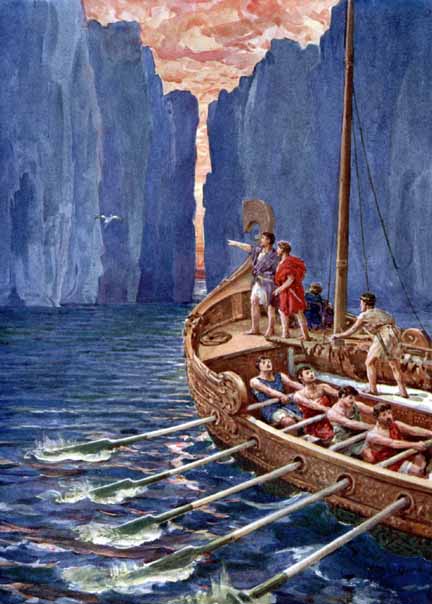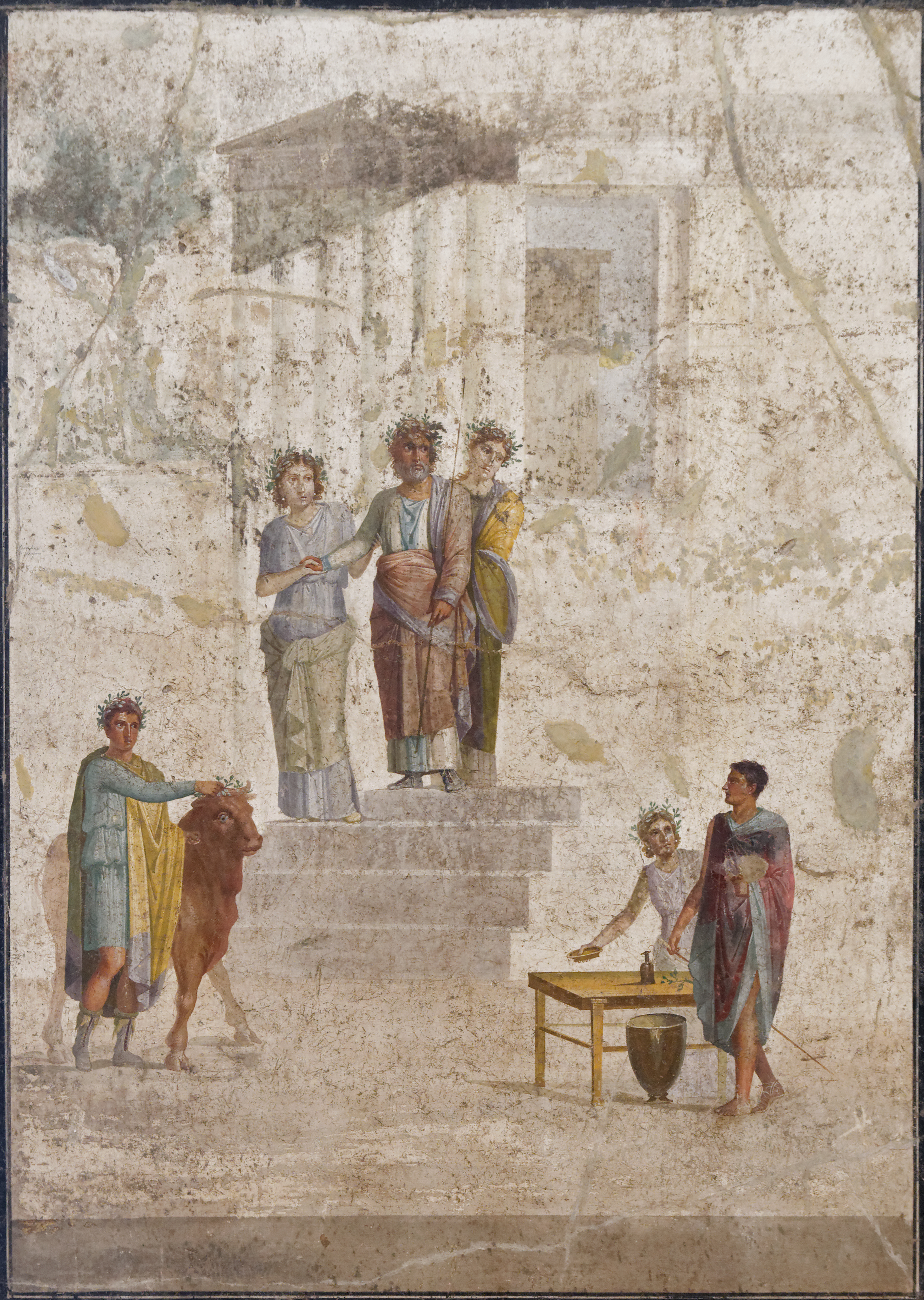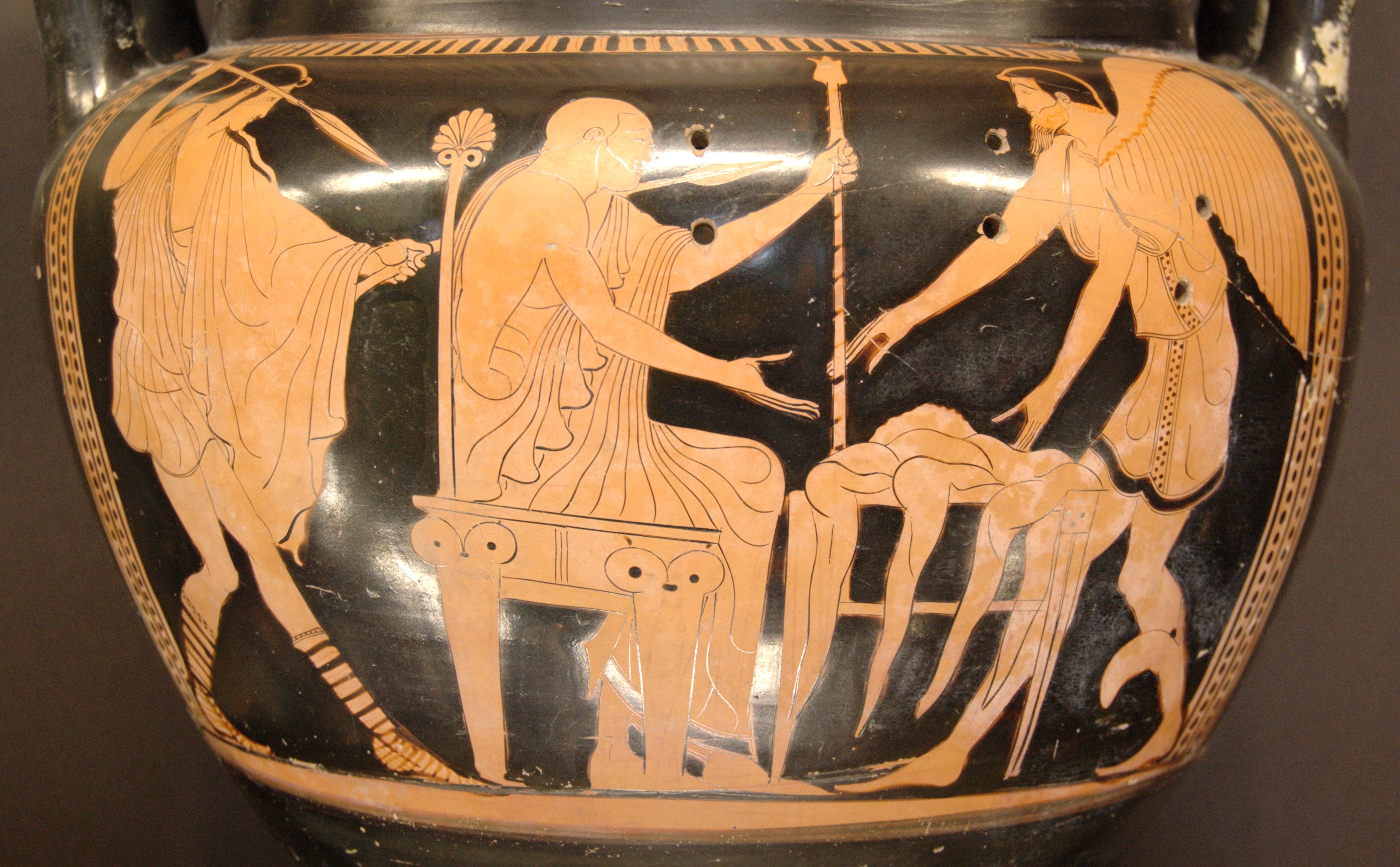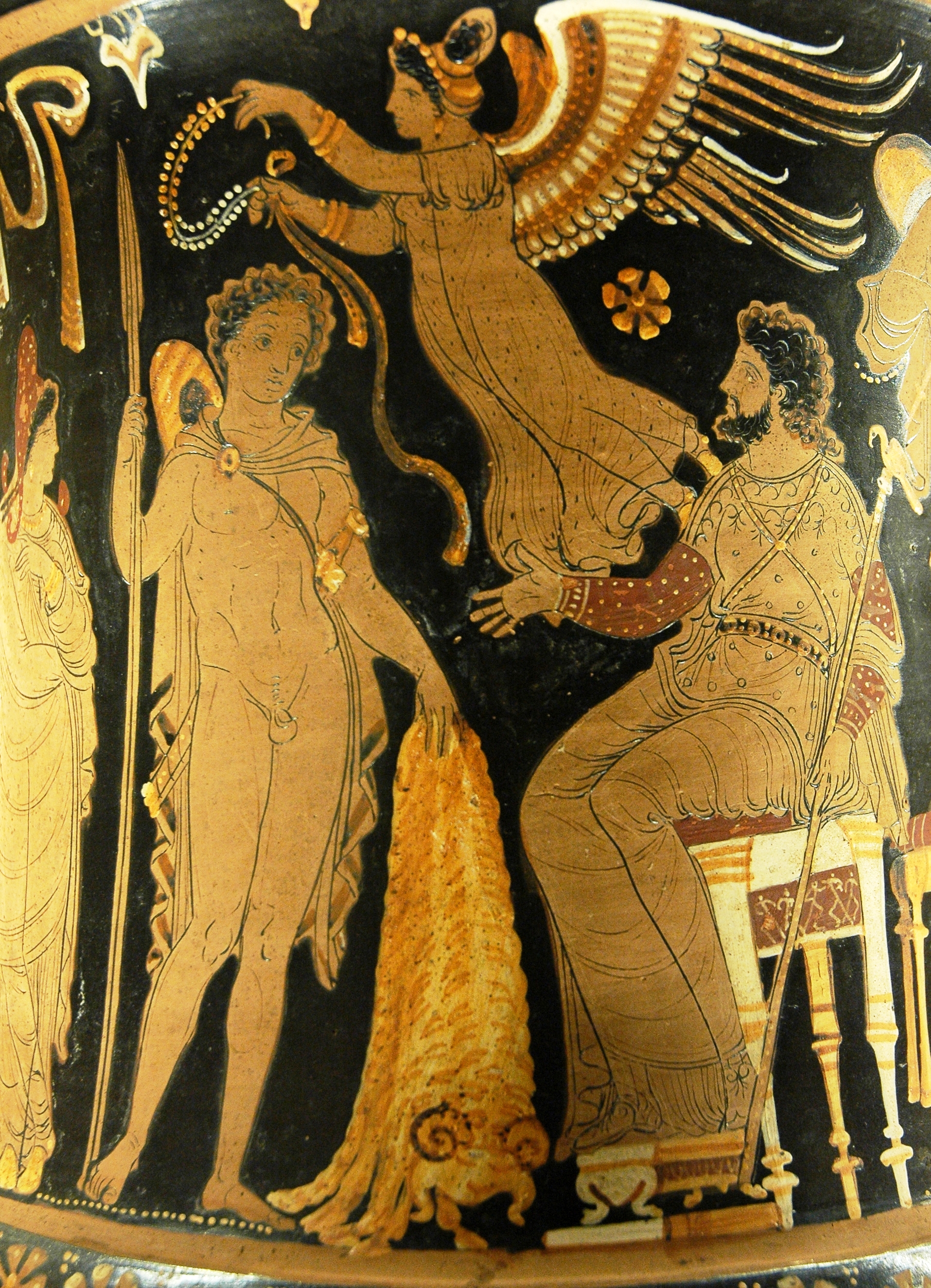|
Symplegades
The Symplegades (; el, Συμπληγάδες, ''Symplēgádes'') or Clashing Rocks, also known as the Cyanean Rocks, were, according to Greek mythology, a pair of rocks at the Bosphorus that clashed together whenever a vessel went through. They were defeated by Jason and the Argonauts, who would have been lost and killed by the rocks except for Phineus' advice. Jason let a dove fly between the rocks to see exactly how fast they'd have to row to beat the rocks; the dove lost only its tail feathers. The Argonauts rowed mightily to get through and lost only part of the stern ornament. After that, the Symplegades stopped moving permanently. The European rock is usually identified with an islet, about wide and long, which stands about off the shore of a village called Rumelifeneri ('Lighthouse of Rumeli’), and is connected to it by a modern concrete jetty. At its highest point, there is an ancient altar known as the Pillar of Pompey, though it has nothing to do with Pompey. Di ... [...More Info...] [...Related Items...] OR: [Wikipedia] [Google] [Baidu] |
Planctae
In Greek mythology, the Planctae ( el, Πλαγκταὶ, ''Planktai'', "Wanderers") or Wandering Rocks were a group of rocks, between which the sea was mercilessly violent. The Argo (led by Jason) was the only ship to navigate them successfully (with divine help from Hera, Thetis, and the Nereids). Jason chose to brave the Planctae instead of braving Scylla and Charybdis. In the ''Odyssey'' of Homer, the sorceress Circe tells Odysseus of the "Wandering Rocks" or "Roving Rocks" that have only been successfully passed by the '' Argo'' when ''homeward'' bound. These rocks smash ships and the remaining timbers are scattered by the sea or destroyed by flames. The rocks lie on one of two potential routes to Ithaca; the alternative, which is taken by Odysseus, leads to Scylla and Charybdis. Furthermore, in the ''Argonautica'', it was Hera, for her love of Jason, who sped the Argo through the Symplegades safely. The rocks also appear on the journey in the ''Argonautica'' by Apollo ... [...More Info...] [...Related Items...] OR: [Wikipedia] [Google] [Baidu] |
Jason
Jason ( ; ) was an ancient Greek mythological hero and leader of the Argonauts, whose quest for the Golden Fleece featured in Greek literature. He was the son of Aeson, the rightful king of Iolcos. He was married to the sorceress Medea. He was also the great-grandson of the messenger god Hermes, through his mother's side. Jason appeared in various literary works in the classical world of Greece and Rome, including the epic poem ''Argonautica'' and the tragedy ''Medea''. In the modern world, Jason has emerged as a character in various adaptations of his myths, such as the 1963 film '' Jason and the Argonauts'' and the 2000 TV miniseries of the same name. Persecution by Pelias Pelias (Aeson's half-brother) was power-hungry and sought to gain dominion over all of Thessaly. Pelias was the progeny of a union between their shared mother, Tyro ("high born Tyro"), the daughter of Salmoneus, and the sea god Poseidon. In a bitter feud, he overthrew Aeson (the rightful king), kill ... [...More Info...] [...Related Items...] OR: [Wikipedia] [Google] [Baidu] |
Yum Burnu
{{Short description, Turkish Cape at the Bosphorus Yum Burnu ( Turkish 'Cape of Good Hope'), the ancient Ancyræan Cape or Ancyræan Promontory and the modern Greek Cape Psomion, is the cape at the northeast end of the Bosphorus, where it enters the Black Sea. It is a bold headland descending almost perpendicularly into the water.''The Black Sea Pilot'', 192 p. 320 Just below it is a reef A reef is a ridge or shoal of rock, coral or similar relatively stable material, lying beneath the surface of a natural body of water. Many reefs result from natural, abiotic processes— deposition of sand, wave erosion planing down rock o ... which is often identified as the Asian side of the mythical Symplegades. Notes Bosphorus ... [...More Info...] [...Related Items...] OR: [Wikipedia] [Google] [Baidu] |
Bosphorus
The Bosporus Strait (; grc, Βόσπορος ; tr, İstanbul Boğazı 'Istanbul strait', colloquially ''Boğaz'') or Bosphorus Strait is a natural strait and an internationally significant waterway located in Istanbul in northwestern Turkey. It forms part of the continental boundary between Asia and Europe, and divides Turkey by separating Anatolia from Thrace. It is the world's narrowest strait used for international navigation. Most of the shores of the Bosporus Strait, except for the area to the north, are heavily settled, with the city of Istanbul's metropolitan population of 17 million inhabitants extending inland from both banks. The Bosporus Strait and the Dardanelles Strait at the opposite end of the Sea of Marmara are together known as the Turkish Straits. Sections of the shore of the Bosporus in Istanbul have been reinforced with concrete or rubble and those sections of the Strait prone to deposition are periodically dredged. Name The name of the ... [...More Info...] [...Related Items...] OR: [Wikipedia] [Google] [Baidu] |
Argonauts
The Argonauts (; Ancient Greek: ) were a band of heroes in Greek mythology, who in the years before the Trojan War (around 1300 BC) accompanied Jason to Colchis in his quest to find the Golden Fleece. Their name comes from their ship, '' Argo'', named after its builder, Argus. They were sometimes called Minyans, after a prehistoric tribe in the area. Mythology The Golden Fleece After the death of King Cretheus, the Aeolian Pelias usurped the throne from his half-brother Aeson and became king of Iolcus in Thessaly (near the modern city of Volos). Because of this unlawful act, an oracle warned him that a descendant of Aeolus would seek revenge. Pelias put to death every prominent descendant of Aeolus he could, but spared Aeson because of the pleas of their mother Tyro. Instead, Pelias kept Aeson prisoner and forced him to renounce his inheritance. Aeson married Alcimede, who bore him a son named Jason. Pelias intended to kill the baby at once, but Alcimede summoned her kinswome ... [...More Info...] [...Related Items...] OR: [Wikipedia] [Google] [Baidu] |
Phineus
In Greek mythology, Phineus (; Ancient Greek: Φινεύς, ) or Phineas, was a king of Salmydessus in Thrace and seer, who appears in accounts of the Argonauts' voyage. Some accounts make him a king in PaphlagoniaScholia on Apollonius of Rhodes, 2.178, 237; Scholia ''ad eund'' 2.177; Eustathius ad Homer, ''Iliad'2.851 ad Dionysius Periegetes, 787; Stephanus of Byzantium, s.v.; Constantine Porphyrogennetos, ''De thematibus'' 1.7; William Smith, ''Dictionary of Greek and Roman Geography'' s.v. Paphlagonia' or in Arcadia. Family Several different versions of Phineus's parentage were presented in ancient texts. According to Apollonius of Rhodes, he was a son of Agenor, but the '' Bibliotheca'' says that other authors named his father as Poseidon (who is the father of Agenor).Apollodorus1.9.21/ref> The Hesiodic ''Catalogue of Women'', on the other hand, reported that Phineus was the son of Phoenix and Cassiopeia. His first wife was Cleopatra, daughter of Boreas and Oreithyia, ... [...More Info...] [...Related Items...] OR: [Wikipedia] [Google] [Baidu] |
Odyssey
The ''Odyssey'' (; grc, Ὀδύσσεια, Odýsseia, ) is one of two major Ancient Greek literature, ancient Greek Epic poetry, epic poems attributed to Homer. It is one of the oldest extant works of literature still widely read by modern audiences. As with the ''Iliad'', the poem is divided into 24 books. It follows the Greek hero cult, Greek hero Odysseus, king of Homer's Ithaca, Ithaca, and his journey home after the Trojan War. After the war, which lasted ten years, his journey lasted for ten additional years, during which time he encountered many perils and all his crew mates were killed. In his absence, Odysseus was assumed dead, and his wife Penelope and son Telemachus had to contend with a Suitors of Penelope, group of unruly suitors who were competing for Penelope's hand in marriage. The ''Odyssey'' was originally composed in Homeric Greek in around the 8th or 7th century BCE and, by the mid-6th century BCE, had become part of the Greek literary canon. In Classic ... [...More Info...] [...Related Items...] OR: [Wikipedia] [Google] [Baidu] |
New Criticism
New Criticism was a formalist movement in literary theory that dominated American literary criticism in the middle decades of the 20th century. It emphasized close reading, particularly of poetry, to discover how a work of literature functioned as a self-contained, self-referential aesthetic object. The movement derived its name from John Crowe Ransom's 1941 book ''The New Criticism''. The work of Cambridge scholar I. A. Richards, especially his ''Practical Criticism'' and ''The Meaning of Meaning'', which offered what was claimed to be an empirical scientific approach, were important to the development of New Critical methodology. Also very influential were the critical essays of T. S. Eliot, such as " Tradition and the Individual Talent" and " Hamlet and His Problems", in which Eliot developed his notions of the "theory of impersonality" and " objective correlative" respectively. Eliot's evaluative judgments, such as his condemnation of Milton and Dryden, his liking for the s ... [...More Info...] [...Related Items...] OR: [Wikipedia] [Google] [Baidu] |
Practical Criticism
Ivor Armstrong Richards CH (26 February 1893 – 7 September 1979), known as I. A. Richards, was an English educator, literary critic, poet, and rhetorician. His work contributed to the foundations of the New Criticism, a formalist movement in literary theory which emphasized the close reading of a literary text, especially poetry, in an effort to discover how a work of literature functions as a self-contained and self-referential æsthetic object. Richards' intellectual contributions to the establishment of the literary methodology of the New Criticism are presented in the books '' The Meaning of Meaning: A Study of the Influence of Language upon Thought and of the Science of Symbolism'' (1923), by C. K. Ogden and I. A. Richards, ''Principles of Literary Criticism'' (1924), ''Practical Criticism'' (1929), and ''The Philosophy of Rhetoric'' (1936). Biography Richards was born in Sandbach. He was educated at Clifton College and Magdalene College, Cambridge, where his i ... [...More Info...] [...Related Items...] OR: [Wikipedia] [Google] [Baidu] |
Henry Treece
Henry Treece (22 December 1911 – 10 June 1966) was a British poet and writer who also worked as a teacher and editor. He wrote a range of works but is mostly remembered as a writer of children's historical novels. Life and work Treece was born in Wednesbury, Staffordshire, and educated at the town's grammar school. After graduating from the University of Birmingham in 1933, he went into teaching with his first placement being at Tynemouth School. In 1939 he married Mary Woodman and settled in Lincolnshire as a teacher at Barton-upon-Humber Grammar School. Their son, Richard Treece, became a musician with Help Yourself and other rock bands. He published five volumes of poetry: ''38 Poems'' (London: Fortune Press, 1940), then by Faber & Faber; ''Invitation and Warning'' 1942; ''The Black Seasons'' 1945; ''The Haunted Garden'' 1947; and ''The Exiles'' 1952. He appeared in the 1949 ''The New British Poets: an anthology'' edited by Kenneth Rexroth; but from 1952 with ''The ... [...More Info...] [...Related Items...] OR: [Wikipedia] [Google] [Baidu] |
Golden Fleece
In Greek mythology, the Golden Fleece ( el, Χρυσόμαλλον δέρας, ''Chrysómallon déras'') is the fleece of the golden-woolled,, ''Khrusómallos''. winged ram, Chrysomallos, that rescued Phrixus and brought him to Colchis, where Phrixus then sacrificed it to Zeus. Phrixus gave the fleece to King Aeëtes who kept it in a sacred grove, whence Jason and the Argonauts stole it with the help of Medea, Aeëtes' daughter. The fleece is a symbol of authority and kingship. In the historical account, the hero Jason and his crew of Argonauts set out on a quest for the fleece by order of King Pelias in order to place Jason rightfully on the throne of Iolcus in Thessaly. Through the help of Medea, they acquire the Golden Fleece. The story is of great antiquity and was current in the time of Homer (eighth century BC). It survives in various forms, among which the details vary. Nowadays, the heraldic variations of the Golden Fleece are featured frequently in Georgia, especially ... [...More Info...] [...Related Items...] OR: [Wikipedia] [Google] [Baidu] |
Apollonius Of Rhodes
Apollonius of Rhodes ( grc, Ἀπολλώνιος Ῥόδιος ''Apollṓnios Rhódios''; la, Apollonius Rhodius; fl. first half of 3rd century BC) was an ancient Greek author, best known for the ''Argonautica'', an epic poem about Jason and the Argonauts and their quest for the Golden Fleece. The poem is one of the few extant examples of the epic genre and it was both innovative and influential, providing Ptolemaic Egypt with a "cultural mnemonic" or national "archive of images", and offering the Latin poets Virgil and Gaius Valerius Flaccus a model for their own epics. His other poems, which survive only in small fragments, concerned the beginnings or foundations of cities, such as Alexandria and Cnidus places of interest to the Ptolemies, whom he served as a scholar and librarian at the Library of Alexandria. A literary dispute with Callimachus, another Alexandrian librarian/poet, is a topic much discussed by modern scholars since it is thought to give some insight into t ... [...More Info...] [...Related Items...] OR: [Wikipedia] [Google] [Baidu] |






